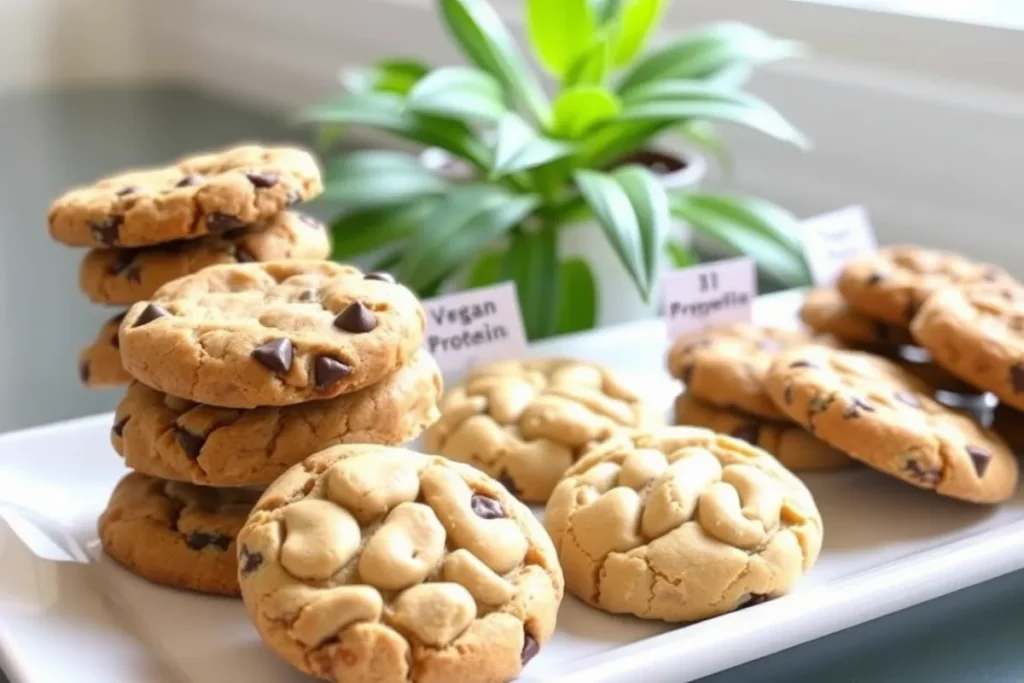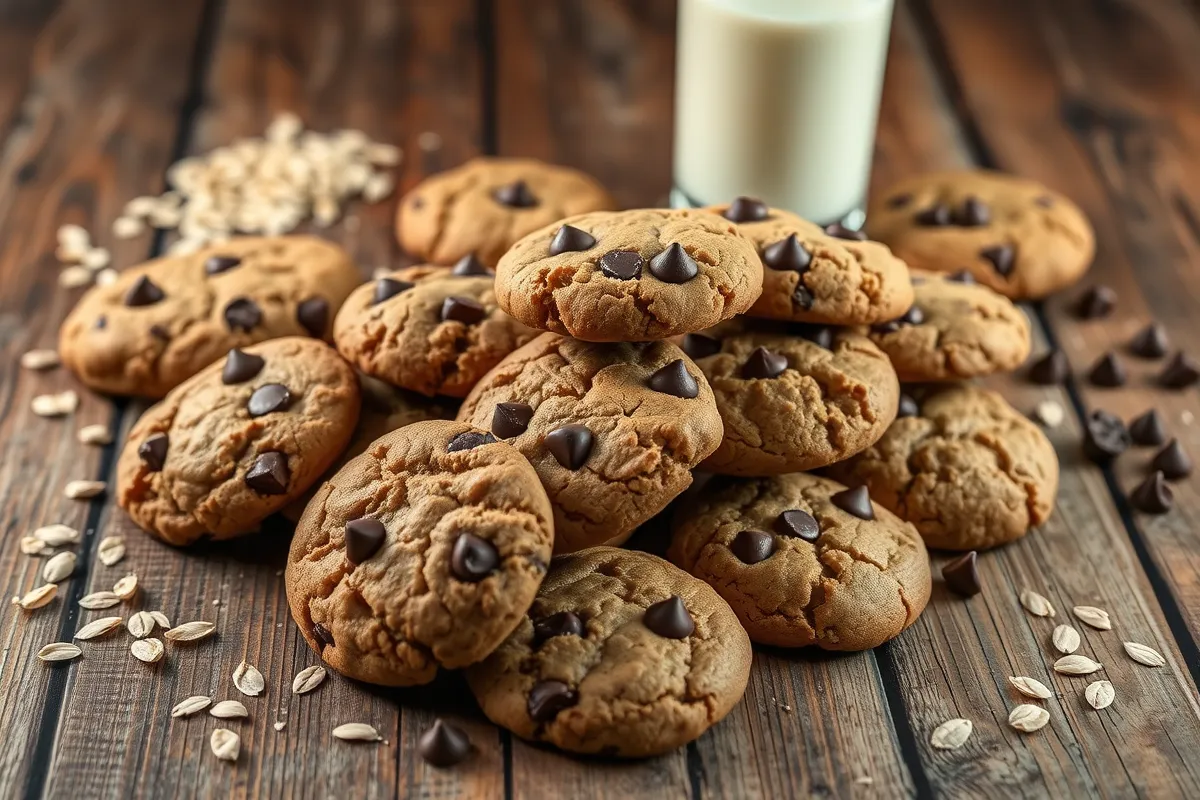Introduction
Protein cookies have gained immense popularity as a healthy snack option for fitness enthusiasts and those looking to indulge without guilt. These cookies are not only delicious but also provide the necessary nutrients to fuel your body. Unlike traditional cookies that are high in sugar and low in nutrition, protein cookies stand out as a more balanced choice.
One of the biggest reasons protein cookies have become a go-to option is their versatility. They are perfect as a post-workout snack, an on-the-go breakfast, or even a midday treat. Whether you are following a fitness regime or simply want a healthier alternative to satisfy your sweet tooth, a well-made protein cookie recipe can do the trick.
Moreover, protein cookies offer the added benefit of keeping you fuller for longer. This can help with weight management and avoiding unnecessary snacking. In this article, we will dive deep into the ingredients, methods, and variations to help you create the perfect protein cookie recipe.
Health Benefits of Protein Cookies
Protein cookies are more than just a tasty treat; they offer a range of health benefits that make them a fantastic addition to your diet. For those seeking a balance between indulgence and nutrition, protein cookies provide the best of both worlds.
A Rich Source of Protein
As the name suggests, protein cookies are packed with protein, an essential macronutrient for muscle building and repair. Whether you’re an athlete or simply looking to maintain a healthy body, consuming enough protein is crucial. Protein helps repair tissues, supports the immune system, and promotes overall body functions.
A Healthier Alternative to Traditional Cookies
Unlike conventional cookies that often contain refined sugar and unhealthy fats, protein cookies are made with more nutritious ingredients. Many recipes replace regular flour with healthier alternatives like almond or oat flour, ensuring a lower glycemic index and fewer empty calories. They often include natural sweeteners, making them a guilt-free option for satisfying your sweet cravings.
Enhanced Satiety and Weight Management
One of the standout benefits of protein cookies is their ability to keep you full for a longer period. Protein is known for its satiating properties, which can help reduce unnecessary snacking throughout the day. Incorporating protein cookies into your diet can contribute to better portion control and support weight management goals.
Ideal for Active Lifestyles
Protein cookies are especially beneficial for people with active lifestyles. They provide a quick and convenient energy boost, making them an excellent post-workout snack. The blend of protein, healthy fats, and carbohydrates in these cookies aids in muscle recovery and replenishment after exercise.
With so many benefits to offer, protein cookies are a nutritious alternative worth exploring. Whether you’re looking for a quick energy boost or a healthier dessert option, they are sure to satisfy your needs.
Key Ingredients in Protein Cookies
Crafting the perfect protein cookie recipe starts with selecting the right ingredients. These components not only define the texture and flavor of your cookies but also ensure they are packed with nutrition. Here’s a breakdown of the essential ingredients that make protein cookies a healthy and delicious treat.
Protein Sources
Whey Protein Powder
Whey protein is one of the most common ingredients in protein cookies. Known for its high-quality protein content, it mixes well with other ingredients and adds a subtle creaminess to the cookies. It’s perfect for those looking to boost their protein intake while maintaining a soft texture.
Plant-Based Protein Powders
For vegan or plant-based enthusiasts, options like pea protein, hemp protein, or rice protein work wonderfully. These powders often have a slightly earthy taste, which can complement flavors like chocolate or peanut butter.
Binders and Sweeteners
Nut Butters
Nut butters such as peanut butter or almond butter are excellent binders for protein cookies. They not only provide a rich and creamy texture but also add healthy fats to the recipe, making the cookies more satiating.
Natural Sweeteners
To keep the recipe on the healthier side, natural sweeteners like honey, maple syrup, or stevia are often used. These alternatives to refined sugar add sweetness without causing a significant spike in blood sugar levels.
Flour Alternatives
Oat Flour
Oat flour is a popular choice for protein cookies because it’s gluten-free, fiber-rich, and easy to incorporate into recipes. It gives the cookies a hearty texture while ensuring they remain light and fluffy.
Coconut Flour
Coconut flour is another excellent option, especially for keto or low-carb variations. It’s rich in fiber and has a mildly sweet taste that pairs well with various cookie flavors.
Optional Add-Ins
To elevate the flavor and nutritional profile of protein cookies, you can include ingredients like dark chocolate chips, chia seeds, flaxseeds, or shredded coconut. These add-ins not only make the cookies more interesting but also provide additional health benefits.
By carefully selecting these key ingredients, you can create protein cookies that are both delicious and nutritious. With the right combination, you’ll have a batch of cookies that cater to your dietary needs without compromising on taste.
Basic Protein Cookie Recipe
Creating a batch of protein cookies at home is simple and rewarding. This basic protein cookie recipe serves as a great starting point, and you can customize it with your favorite flavors or dietary preferences.
Ingredients List
To make around 12 protein cookies, you’ll need the following ingredients:
- 1 cup oat flour (or any flour alternative of your choice)
- 1/2 cup protein powder (whey or plant-based, depending on preference)
- 1/4 cup nut butter (peanut butter or almond butter works best)
- 1/4 cup natural sweetener (honey, maple syrup, or agave syrup)
- 1/4 cup milk (dairy or plant-based)
- 1 teaspoon vanilla extract
- 1/2 teaspoon baking soda
- 1/4 teaspoon salt
- Optional add-ins: 1/4 cup dark chocolate chips, chopped nuts, or dried fruits
Step-by-Step Preparation
- Prepare the Wet Ingredients:
In a large mixing bowl, combine the nut butter, natural sweetener, milk, and vanilla extract. Mix until the ingredients are well blended and smooth. - Combine the Dry Ingredients:
In a separate bowl, whisk together the oat flour, protein powder, baking soda, and salt. Ensure there are no lumps in the mixture. - Mix Wet and Dry Ingredients:
Gradually add the dry ingredients to the wet mixture. Stir with a spatula or spoon until a thick dough forms. If the dough feels too dry, add a splash of milk; if too wet, add a bit more flour. - Fold in Add-Ins:
Gently fold in any optional add-ins like dark chocolate chips or nuts. This step adds flavor and texture to your protein cookies.
Baking Instructions
- Preheat your oven to 350°F (175°C) and line a baking sheet with parchment paper.
- Scoop the dough using a tablespoon or cookie scoop and place it onto the baking sheet. Flatten each scoop slightly with the back of a spoon to form a cookie shape.
- Bake for 8-10 minutes, or until the edges are lightly golden. Avoid overbaking to keep the cookies soft and chewy.
Nutritional Information per Serving
While the exact values may vary depending on the ingredients used, each cookie approximately contains:
- Calories: 120
- Protein: 7 grams
- Carbohydrates: 10 grams
- Fats: 5 grams
This basic recipe is a versatile foundation for creating protein cookies that suit your tastes and dietary needs. Experiment with flavors and add-ins to make them uniquely yours.
Variations of Protein Cookies

One of the best aspects of making protein cookies is the endless variety of flavors and adaptations you can try. Whether you’re catering to specific dietary needs or just want to mix things up, there’s a protein cookie variation for everyone.
Flavor Variations
Chocolate Chip Protein Cookies
For classic cookie lovers, chocolate chip protein cookies are a must-try. Simply fold in dark or semi-sweet chocolate chips into the dough before baking. For added indulgence, sprinkle a few extra chips on top of each cookie before placing them in the oven.
Peanut Butter Protein Cookies
Peanut butter fans will love this variation. Replace the regular nut butter in the recipe with creamy or crunchy peanut butter and add chopped peanuts for extra crunch. The rich, nutty flavor pairs wonderfully with chocolate chips or a drizzle of melted chocolate.
Vegan Protein Cookies
For a vegan-friendly option, swap whey protein powder with plant-based alternatives like pea or hemp protein. Use a flax egg (1 tablespoon flaxseed meal mixed with 3 tablespoons water) as a binder instead of regular eggs. Plant-based milk and natural sweeteners like agave syrup complete this variation.
Dietary Modifications
Gluten-Free Protein Cookies
To make your protein cookies gluten-free, ensure all ingredients, especially the flour and protein powder, are certified gluten-free. Almond flour or a gluten-free oat flour blend works perfectly.
Keto-Friendly Protein Cookies
For those on a ketogenic diet, replace the oat flour with almond flour and use erythritol or monk fruit sweetener instead of honey or maple syrup. Coconut oil or unsweetened nut butter can add healthy fats, keeping the cookies in line with keto macronutrient ratios.
High-Fiber Protein Cookies
Boost the fiber content of your cookies by incorporating ground flaxseeds, chia seeds, or psyllium husk into the dough. These ingredients not only enhance the nutritional profile but also add a slight crunch or chewiness to the texture.
Unique Additions for Extra Flavor
To elevate your protein cookies even further, consider adding these unique ingredients:
- Spices: Cinnamon, nutmeg, or cardamom for a warm, aromatic flavor.
- Fruit Zest: Lemon or orange zest for a refreshing citrus twist.
- Extracts: Almond, coconut, or mint extract to diversify the flavor profile.
With these variations and modifications, protein cookies can become a versatile snack that fits seamlessly into any lifestyle or dietary preference.
Tips for Baking Perfect Protein Cookies
Baking protein cookies can sometimes be tricky, especially if you’re experimenting with new ingredients. However, with a few essential tips, you can ensure your cookies turn out perfect every time.
Ensuring Proper Texture and Moisture
Protein cookies are prone to dryness because protein powders absorb more liquid than traditional ingredients. To prevent this:
- Use enough wet ingredients: Nut butters, natural sweeteners, and milk add moisture to the dough. If the dough feels too dry, add a splash of milk or a bit more nut butter.
- Avoid overbaking: Protein cookies can become dry if baked too long. Remove them from the oven as soon as the edges turn golden. They will continue to firm up as they cool.
Avoiding Common Pitfalls
Some common issues can arise when making protein cookies. Here’s how to troubleshoot them:
- Too crumbly: If your cookies crumble easily, the dough may need more binding agents like eggs or flax eggs.
- Too dense: To lighten the texture, sift your dry ingredients before mixing and avoid overmixing the dough, which can make the cookies heavy.
- Lacking flavor: Protein powders can sometimes have a bland or chalky taste. Counter this by using flavorful add-ins like dark chocolate, spices, or extracts.
Storage Recommendations for Freshness
To keep your protein cookies fresh and delicious for longer:
- Store them in an airtight container at room temperature for up to 3 days.
- For longer storage, place them in the fridge for up to a week.
- To enjoy them beyond a week, freeze the cookies in a resealable bag or airtight container for up to 3 months. Thaw at room temperature before serving.
With these practical tips, your protein cookies will not only taste amazing but also maintain their quality over time.
Frequently Asked Questions about Protein Cookie (FAQs)
Are protein cookies healthy?
Yes, protein cookies are generally healthier than traditional cookies when made with wholesome ingredients. They are packed with protein, healthy fats, and natural sweeteners, making them a balanced snack option. However, the nutritional value depends on the specific ingredients used. Always check the recipe or label to ensure it meets your dietary needs.
Can I use protein powder instead of flour for cookies?
While you can use protein powder as a partial substitute for flour in cookies, it’s not recommended to replace it entirely. Protein powder lacks the structural properties of flour, which can affect the texture and stability of your cookies. Combining protein powder with flour alternatives like oat or almond flour yields the best results.
Why are protein cookies so dry?
Protein cookies can become dry due to the absorbent nature of protein powder. To prevent this, ensure you use enough wet ingredients such as nut butters, milk, or eggs. Additionally, avoid overbaking, as it can further dry out the cookies.
What is the healthiest type of cookie?
The healthiest type of cookie depends on your dietary goals. Protein cookies made with natural ingredients, minimal sugar, and healthy fats are an excellent option. Variations like vegan or gluten-free protein cookies cater to specific dietary needs while maintaining their nutritional value.
If you liked this Protein Cookie Recipe, you will certainly benefit from the recipes in our breakfast category.
Conclusion
Protein cookies are the perfect balance of nutrition and indulgence, offering a healthy alternative to traditional cookies. They’re versatile, customizable, and easy to make at home. Whether you’re an athlete seeking post-workout recovery, a busy professional in need of a quick snack, or someone looking to satisfy a sweet tooth guilt-free, a well-made protein cookie recipe fits seamlessly into any lifestyle.
With the right ingredients, tips, and creative variations, you can transform simple cookies into nutritious power-packed treats. Experiment with flavors, adjust the recipe to your dietary needs, and enjoy the benefits of a snack that’s both delicious and good for you.
So, gather your ingredients and start baking today—because your next favorite protein cookie is just a recipe away!


1 thought on “How to Make the Best Protein Cookie Recipe”
Comments are closed.